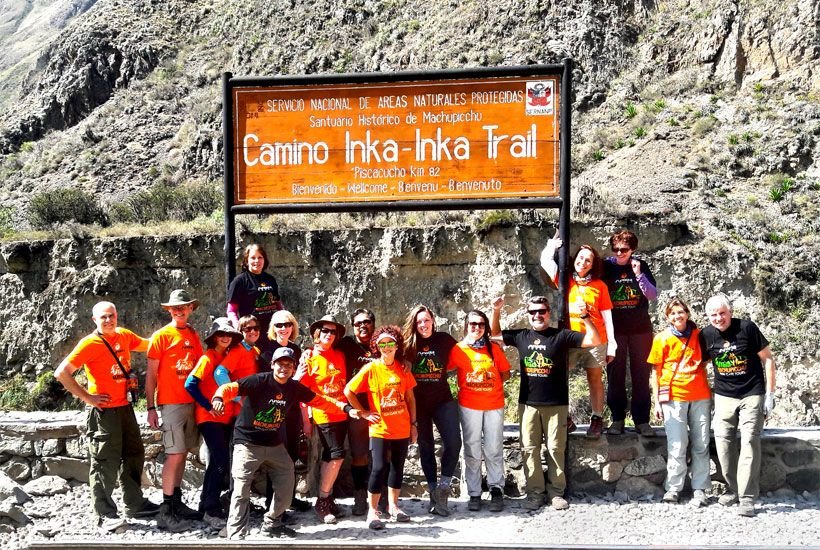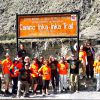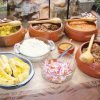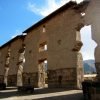What to Know About the Inca Trail
Although Machu Picchu can be reached by train or trekking on alternative trails from Aguas Calientes. There is nothing that quite compares to the authentic Inca Trail (Camino Inka). Celebrated as Peru´s most famous hiking trail and one of the world´s most iconic trekking experiences. This trek exposes you to an impressive combination of sub-tropical Andean mountain environments, including cloud forests, alpine tundra and jungle, and a spectacular array of ancient, Incan archaeological sites!

Length:
The classic Inca Trail is 82km/50 miles and is usually completed on 4D/3N itinerary. But can be either lengthened by a day or shortened to a 2D/1N trek called the ¨Short Inca Trail¨. There is also an option to combine the Salkantay trek with the Inca Trail for an epic and challenging 7D/6N adventure!
Altitude:
The highest point reached on the trail is 4,224 feet/13,860 feet. The Inca Trail is even more challenging due to the high altitude region. All travelers should stay in Cusco for at least two days to get acclimated and reduce the chances of altitude sickness. Some types to avoid altitude sickness on the Inca Trail include drinking mate de coca tea, chewing on coca leaves, staying hydrated, replenishing yourself with foods rich in Potassium, and perhaps even buying altitude sickness pills beforehand in pharmacies.
Can anyone do the Inca Trail?
Peruvians highly value this original unpaved trail and the surrounding environment. Therefore, it is a privilege to have the experience to do the Inca trail. Only 500 people per day are able to do the trial per day, 300 being cooks, guides, and porters. You MUST pre-purchase the permit at least a few months in advance. Permits can sell out as earlier as 6 months in advance, so it is recommended to buy the tickets sooner than later!
Best time to do the Inca Trail:
There are two seasons- the dry and the wet season. The wet season is from November to March, and the dry season is between April and October. As expected, the dry season is more ideal and popular for tourists, but it is winter for other parts of South America so there are generally fewer travelers. IMPORTANT: The trail is closed in February due to the rainy season and maintenance. Which makes it difficult to access the trails.
What to Bring to the Inca Trail:
- One of the essentials is a good quality pair of worn-in hiking shoes (if you do the trail from October to April, make sure that you have waterproof hiking shoes
- A sleeping bag designed for low temperatures is necessary for this trek. During the first and second nights, the temperatures can drop below 0 degrees Celsius, 32 degrees Fahrenheit. (if you do not own a sleeping bag/cannot fit it in your suitcase, you will be able to rent one)
- Thermal socks, hat, heavy jacket, light jacket, long sleeve shirts, hiking pants, t-shirts, underwear, hats, gloves, sunglasses, tennis shoes or sandals for the campsite, first aid kit, toilet paper, sunscreen, insect repellent, flashlight, and a water bottle will all be essential for this trek
- If you are doing the trail during the rainy season, you should bring a raincoat or a rain poncho
- Remember: only pack enough things in your backpack that you will be able to comfortably carry with you throughout the entire trek!
Comforts Available During the Inca Trail:
- Each group includes a local trained cook as well as a local assistant trained cook. These two will prepare delicious and nutritious meals for you throughout the trek to keep you energized. Vegetarian meals are available upon request with no extra charges. Our breakfasts will include milk, coffee, hot chocolate, a variety of teas, bread, butter, orange or strawberry jam, oatmeal, and/or eggs. The lunches and dinners include soups, fish, beef, chicken, vegetables, rice, and potatoes.
- During the trial, you will find access to basic toilets and regular bathrooms.
- You will be able to shower on the third day if you purchase a ticket for 2 USD, with a towel rental of 1.50 USD. On the second day, some hikers choose to jump in the creek to freshen up. Warning: it can be quite cold!
- Tap water will be available during the entire trek. If you choose to drink this water, please make sure to bring water purification pills (can be bought in Cusco), as the water is not potable.
- You will be able to purchase water bottles, Gatorade, batteries, toilet paper, and snacks along the trail.
Fitness Preparation Tips:
The Inca Trail trek is considered a moderate to tough trek. You don´t need to be a super-fit or a marathon runner, but you should be in relatively good shape and have trained for a few months upon arrival. If you are currently unfit, we recommend starting a training program 3-6 months before your trek and focus on one or two cardiovascular exercises. The best type of training is to do aerobic cardiovascular exercises such as long-distance jogging, swimming, or cycling. One highly recommendable idea would be to do a long trail hike, about 8-16 km (5-10) once a week.
Furthermore, it is beneficial to do leg strengthened exercises before. Please note, on the flip side to having a strong cardiovascular system. The fitter you mean that you will push yourself harder on this trek. This is a mistake, as exertion at high altitude causes altitude sickness. Hence, make sure to go slowly on your trek, especially on the ascents upwards and overpasses. Remember: you want to support your strong cardiovascular system to support the high altitude, not strain the system. Make sure to contact your doctor for advice beforehand if you have asthma, a respiratory condition, or a heart condition. Facebook.



















